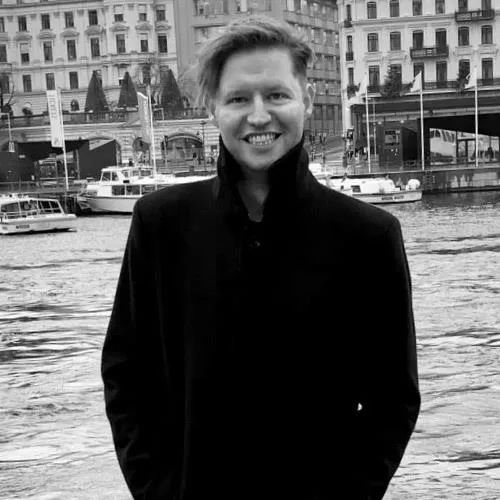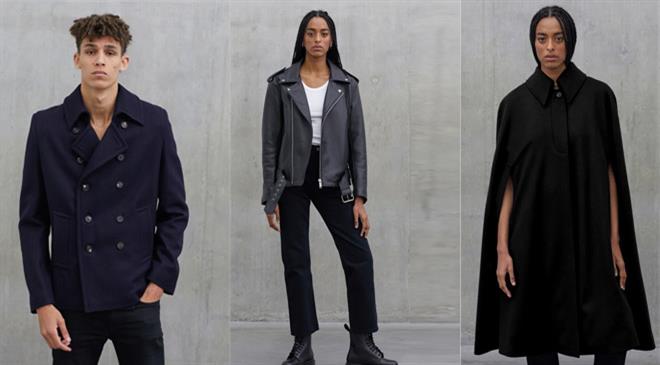
Matthew Hegarty
Founder
Brand - Hegarty
I really want to design fashion for everyone
Matthew Hegarty is the founder of Hegarty, a ready-to-wear fashion brand based in London. The brand was founded with a fundamental premise of creating a collection of iconic outerwear that both women and men would want to wear every day, with a focus on distinctive design, enduring style, and an uncompromising quality that is all made sustainably in London with English fabrics. In an interview with Fibre2Fashion, Matthew talks about the distinctive style of his collections, his creative process, obstacles he faced while creating the brand, and a lot more.
Fibre2Fashion: What motivated you to create a fashion brand focused on outerwear, and what was the inspiration behind creating gender-neutral pieces?
Matthew Hegarty:
I started out as a fashion photographer, and so I was always looking at clothes and fashion. I felt in my core that making fashion was something I really had to do creatively. So, I started. I love coats and outerwear, and a fantastic coat or jacket can just make the outfit. Also, few of my favourite British designers make their pieces in the UK. I really felt that I wanted to create a fashion brand that begins with outerwear, that’s sustainable, and made in London, and next month marks Hegarty’s two-year anniversary!
F2F: Could you elaborate on the distinctive design and style of your collections?
MH:
It isn’t enough to just say “I’m going to make a denim jacket or a trench coat.” There has to be something distinctive and unique about your collection. For example, my denim jacket has a raglan sleeve and a box pleat at the back. I can’t find anything like it, and it is unique and distinctive, but it’s also a denim jacket that’s wearable and looks great. All Hegarty pieces have a throughline that connects them all together to make the collection cohesive. I don’t want one single piece to stand out in a negative way. When I design a new piece, it has to make sense next to the others. The cloak is one of the newest additions to the collection; it has a beautiful pleat down the back, which is a Hegarty signature.
F2F: Can you share some details about the creative process that goes into designing your collections?
MH:
I’m thinking of ideas for new pieces all the time. When I’m working on a new piece, I often find that during the design process, I’ll have ideas for something else. Hegarty obviously keeps me super busy, and I love working, so the busier I am, the more ideas I tend to find. I don’t like to stop! I’m always looking back at my favourite photographers and artists for inspiration, and I’m a pretty huge film fan. I’ve always got a lot out of cinema and how fashion is represented in cinema, and this is still a very important resource for my inspiration.
F2F: How do you maintain your brand’s uncompromising quality while also prioritising sustainability?
MH:
May 2023 will mark two years since Hegarty was launched. To get to the point where I was able to launch, I had to find the right manufacturers and suppliers. The quality of the UK’s fabrics and manufacturing is so incredibly high, in fact, I would say that it’s as high as any other country that makes luxury products. Because I source my fabrics from England and my collection is made in London, when I look at each piece, I can wholeheartedly say that there is absolutely no compromise on quality. Hegarty only uses the finest fabrics and trims from England and the UK, and so to maintain our very high standards, all I do is to continue to source my fabrics and trims from the UK.
F2F: What is your approach to procuring English fabrics for use in your collections?
MH:
I buy from a pretty select group of fabric manufacturers. I really absolutely love what they produce! I also love that they have been making the same type of fabrics for a very long time and have committed to continue to make them. This helps to make Hegarty more sustainable and my business scalable. When I have new ideas for new pieces I usually go through my current suppliers and ask them if they have what I’m looking for. If they do, they send me out some swatches. If they’re what I’m looking for, I then decide how and where I’m going to use them. This is definitely one of my favourite parts of the process. I’m completely committed to buying fabrics for Hegarty in England and the UK. I just love how local it really can be and is.
F2F: Can you share some of the obstacles you faced while creating and expanding your brand? How did you overcome them?
MH:
Sampling. As soon as I have a new design that I think works, I then get a sample into production. This starts with the pattern, and then I source the fabrics. I usually make my samples in what I think might be the final fabrics. This really helps me to visualise the final piece. I then try it on various people to see how it looks. This can take a while. It’s hardest when it’s a unisex piece because it needs to work across genders and various sizes and different body types. However, when it finally comes together, it’s definitely worth it and very rewarding!
F2F: How do you ensure that your brand remains true to its founding principles while constantly evolving and growing?
MH:
I really want to design fashion for everyone and that’s why making unisex pieces is so important. Coupled with this idea, I will still make my collections in the UK and more specifically London. I will never make fast fashion. Hegarty will always be made sustainably and in the UK and London. We all know that it is cheaper to manufacture abroad, but as the designer and founder of a brand from England, I have no intention of manufacturing elsewhere.
F2F: How do you strike a balance between creativity and authenticity?
MH:
It’s such an important challenge for me, as this dichotomy is at the centre of all my designs. Creativity is essential for all of my designs to be different, relevant, and inspirational. Not just different for difference’s sake. There has to be vision, which should also come with a respect for the true organic nature of the fabrics and what they’ll be made into, hence the need for authenticity. So basically, I start with the creative idea coupled with the objective to make my design the most dynamic and engaging as possible. This then determines how the fabric will be cut and which fabric and trims will be used, all of which must be sustainable and ethical. Also, I work with manufacturers that I can trust.
F2F: Could you offer some styling tips for wearing outerwear, as well as some essential wardrobe items for fashion aficionados?
MH:
I still think layering and sizing up is the key. It’s also great fun and stylish too! I love layering jackets under coats with just a plain T-shirt or shirt underneath. Then, depending on the day or occasion, some smart trousers or great jeans with a favourite relevant boot or shoe (for boots and shoes, I love Trickers and Churchs. I’m also partial to a pair a Saint Laurent Chelsea boots).
F2F: What is the vision for your brand’s growth and evolution in the coming years?
MH:
The first thing I want to do is to expand the collection into more ready-to-wear pieces and accessories. I want Hegarty to not only be known as a fashion brand that makes beautifully designed and manufactured outerwear but also as a brand that has really expanded into the other main fashion categories. I’m working on designs right now that I'm really excited about in the other categories, so do keeping checking in with us!

Anurag Batra
Rahul Mehta
Bill D’Arienzo
Gabi Seligsohn
Pradip Mehta
Fanny Vermandel
Abhay Gupta
Arun Sirdeshmukh
Aseem Prakash
Rahul Mehta



20230103183907.png)









_8.JPG)

